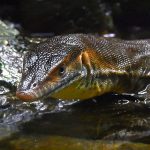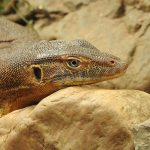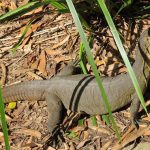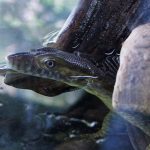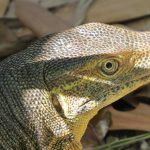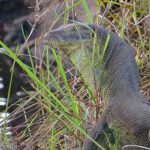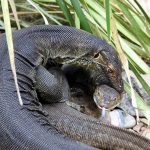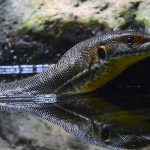MERTENS' WATER MONITOR
Sharon: The Merten’s Water Monitors that I have had ‘Close Encounters’ with have mainly been in outback Australia, mainly in Queensland & the Northern Territory. They love hanging around the outback waterways and are often seen swimming from bank to bank.
Mertens’ Water Monitors: Nature’s Aquatic Acrobats
Mertens’ water monitors are primarily found across northern Australia. Their habitat stretches from the Kimberly region in Western Australia, across the Top End of the Northern Territory, and into western Queensland. They have a particular affinity for water and are often spotted basking on the banks of rivers, creeks, billabongs, and even mangrove swamps. This remarkable reptile is a true spectacle of the Australian wild, and it has some unique characteristics that set it apart from other creatures.
Fascinating Features at a Glance
| Feature | Details |
|---|---|
| Scientific Name | Varanus mertensi |
| Size | Up to 1.2 metres (snout-to-tail) |
| Habitat | Rivers, creeks, billabongs, mangrove swamps (N. Australia) |
| Diet | Fish, frogs, reptiles, insects, carrion—a true buffet! |
| Egg-laying | Usually in termite mounds |
| Conservation | Least concern (but keeping an eye on threats) |
Splendid Swimmers
Mertens’ water monitors are That laterally compressed tail? It works just like a mighty rudder, making these lizards as agile underwater as they are on land.
- Fun Fact: They can remain submerged for up to 30 minutes!
- Their nostrils are placed on top of their snouts.
Omnivorous Opportunists
They don’t just settle for whatever floats by; Mertens’ monitors are active hunters and clever opportunists:
- Active foraging: Scouring water and land for prey.
- Ambush tactics: Waiting in hiding before pouncing with surprising speed.
- Diet buffet: If you can wriggle, hop, or float, you’re on the menu!
Family Planning, Monitor-Style
Choosing a termite mound for a nursery is a stroke of reptilian genius. The internal heat of an active mound provides a constant, comfortable temperature, perfect for egg incubation—with barely any ‘baby monitor’ required.
- Incubation period: ~8 to 9 months—a long wait for some little lizards!
Ecological Significance
These monitors are not simply show-offs; they are keystone species in the web of life:
- Predators: Regulate populations of fish, amphibians, and invertebrates.
- Prey: Serve as a snack for crocs, raptors, and even larger goannas.
- Ecosystem health indicators: Their presence reflects the vitality of waterways.
Thermoregulation Pros
Whether sunbathing after a chilly swim or escaping to burrows during the midday broil, these lizards have thermoregulation down to an art.
Conservation: Past the “Least Concern” Label
While currently stabilised, Varanus mertensi now face:
- Cane toad invasion: Eating a single toxic toad can be fatal—a threat slithering steadily south.
- Habitat change: Dams and water pollution can disrupt precious aquatic habitats.
So, although their conservation status is not yet critical, vigilance is the name of the game.
Mertens’ water monitors are living proof of Australia’s ecological ingenuity. Balancing aquatic agility, a varied diet, and ecosystem significance, they inspire appreciation—and remind us why conservation is more than just a buzzword.

